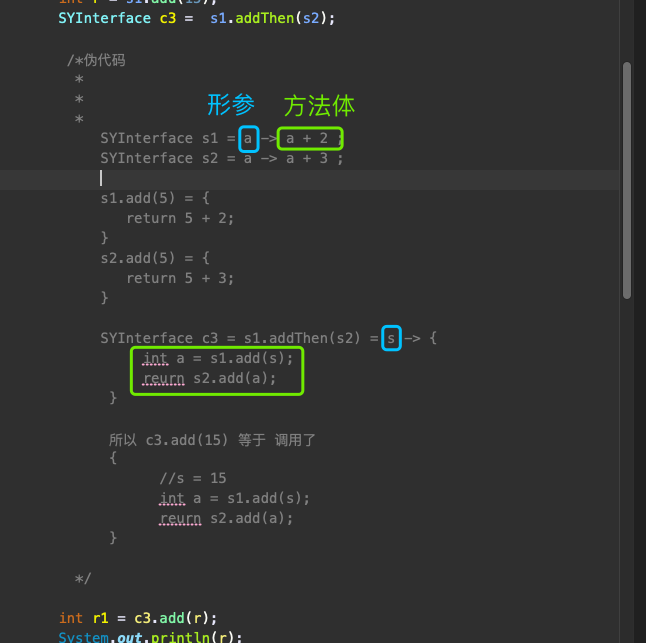Lambda表达式addThen的理解
先定义一个接口类
public interface SYInterface {
int add(int a);
default SYInterface addThen(SYInterface after)
{
return (s) -> {
int a = add(s);
return after.add(a);
};
// 或者
// return s-> {
// return after.add(add(s));
// };
}
}
测试类里面
public class SYAddThenDemo {
public static void main(String[] args) {
SYInterface s1 = a -> a + 2 ;
SYInterface s2 = a -> a + 3 ;
test1(a -> a + 100);
test2(s -> s + 16,s -> s + 1);
test1(s1);
test2(s1,s2);
}
static void test1(SYInterface ic)
{
int r = ic.add(15);
System.out.println(r);
}
static void test2(SYInterface s1,SYInterface s2)
{
// int a = s1.addThen(s2).add(15);
SYInterface c3 = s1.addThen(s2);
int r1 = c3.add(15);
System.out.println(r1);
}
}
每次看到这段代码我都是一脸懵逼 int a = s1.addThen(s2).add(15);,为什么它会先调用 s1 的 add 方法,然后调用 s2 的 add 方法。
天资愚钝,思考了一晚上和一个上午,终于理解了,现在记录下推导过程,以防后面再次迷糊。
先来看一段代码
test1(new SYInterface() {
@Override
public int add(int a) {
return a + 15;
}
});
这里使用了匿名类来实现,没什么问题,当 test1 方法里面 SYInterface ic 调用 ic.add() 的时候就是调用 匿名类里面的 add 方法。
根据规则,我们可以把匿名类这段实现修改为:
test1(a -> a + 15);
其实就是
SYInterface ic = a -> a + 15;
test1(ic);
然后当 ic 调用 add 的时候,其实就是 调用 a + 15;
这段具体的规则就不讲了,继续往下
上面的理解以后,我们调用接口 SYInterface 的 add 方法的时候,其实就是调用
int add(int a) {
return a + 15
}
然后我们看下 addThen 的实现
default SYInterface addThen(SYInterface after)
{
return (s) -> {
int a = add(s);
return after.add(a);
};
// 或者
// return s-> {
// return after.add(add(s));
// };
}
是传入一个 SYInterface 参数返回一个 SYInterface 的结果。
所以 伪代码
SYInterface s1 = a -> a + 2 ;
SYInterface s2 = a -> a + 3 ;
s1.add(5) = {
return 5 + 2;
}
s2.add(5) = {
return 5 + 3;
}
SYInterface c3 = s1.addThen(s2) = s -> {
int a = s1.add(s);
reurn s2.add(a);
}
所以 c3.add(15) 等于 调用了
{
//s = 15
int a = s1.add(s);
reurn s2.add(a);
}
